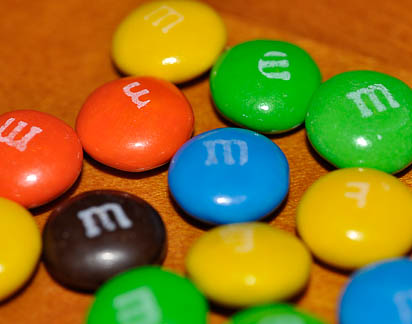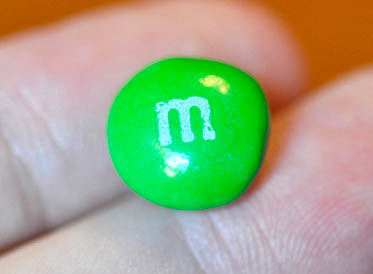
In looking at the food web, we are trying to see how energy is transferred from one living thing to another. As part of that study, we need to be able to measure that energy. Luckily that involves something that you are probably very familiar with.
- 1 M&M candy, or a small candy that tells you how many calories it contains
In our food conscious world, we hear a lot about calories, but most people don't really know what a calorie is. Calories are a measure of energy. One calorie is the heat energy that it takes to raise the temperature of one gram of water by one degree Celsius.
There is some confusion, since in the food industry; the word Calorie actually refers to a kilocalorie, which is one thousand actual calories. The nutritional Calorie is spelled with a capital "C," while the actual calorie has a lower case "c". One nutritional Calorie has enough energy to raise the temperature of one kilogram of water by one degree Celsius. That means that a piece of candy that contains 200 nutritional Calories has enough chemical energy stored in it to raise the temperature of 200 kilograms (200 liters) of water by one degree.
When you eat food, your body has two choices. It can use the Calories, or it can store them for later. To maintain a steady body weight, we need to use as many Calories as we consume. Depending on what you eat, and how much you exercise that can be a challenge. To give you an idea of what it takes to use up the Calories, lets try an example.

Pick up one M&M candy. Look at it carefully. Not very big, is it? And it only contains 4.3 nutritional Calories. Not much at all, right? Now, eat the candy. So far, this is a really fun experiment.
Now, lets burn up the Calories from that tiny piece of candy. To do that, you have to walk at a brisk pace for 100 yards, the length of a football field. No, just sitting there thinking about walking will not have the same result. Get up and actually walk. After walking that distance, you will have burned about the same amount of energy as was in the candy.
Now, think about eating an entire bag of M&Ms. For each 18 pieces of candy that you eat, you would have to walk just over a mile, so even a small bag of candy would mean several miles of walking.
Look at some other foods, to see how far you would have to walk. You will be amazed at how much energy you consume. But wait a minute! If you look at guides to nutrition, most recommend a diet of about 10 Calories for each pound of your weight each day. If you weigh 150 pounds, then a healthy diet should include about 1,500 Calories. To walk that off, you would have to walk almost 20 miles a day! What is going on?
Well, not all the Calories you eat are used for exercise. Much that energy goes toward producing heat, to keep your body at a constant 98.6 degrees. It varies from person to person, but about 800 to 1,000 of the calories that the average person eats will go towards producing the heat that maintains your body temperature. The rest of the Calories go towards keeping your body running and letting you do the things that you do every day.
If you eat more calories, then you need to exercise more, to keep your body from storing that energy as fat. That's why I spend so much time hiking with 30 pounds of camera equipment on my back. Besides, the fun I have with nature photography, it also helps me burn off all the ice cream, chocolate sauce, whipped cream, etc.
The same is true for other living things. Some of their energy is used in the processes of life, but some of it is stored in their bodies. That stored energy is the reason that animals eat plants and other animals. Producers and the things that eat them are the only source of the energy that living things need to survive.
